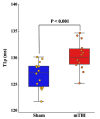Assessment of White Matter Changes Using Quantitative T1ρ Mapping in an Open-Field Low-Intensity Blast Mouse Model of Mild Traumatic Brain Injury (mTBI)
- PMID: 40564895
- PMCID: PMC12193592
- DOI: 10.3390/ijms26125431
Assessment of White Matter Changes Using Quantitative T1ρ Mapping in an Open-Field Low-Intensity Blast Mouse Model of Mild Traumatic Brain Injury (mTBI)
Abstract
Blast-induced mild traumatic brain injury (mTBI) occurs when shock waves travel through blood vessels and cerebrospinal fluid, leading to cerebral demyelination, which results in cognitive impairments and neuropsychiatric issues that impact quality of life. This study aims to evaluate myelin changes in white matter in mice with mTBI induced by an open-field low-intensity blast (LIB) using a newly implemented 3D adiabatic T1ρ prepared fast spin echo (Adiab-T1ρ-FSE) sequence for quantitative T1ρ MRI mapping. Thirty male C57BL/6 mice, including 15 mTBI and 15 sham controls, were scanned on a 3T Bruker MRI scanner. Luxol fast blue (LFB) staining was performed to assess myelin content differences between the mTBI and sham control groups. A significantly higher T1ρ value in the medial corpus callosum (MCC) was found in mTBI mice compared to controls (126.8 ± 2.5 ms vs. 129.8 ± 2.5 ms; p < 0.001), consistent with the reduced myelin observed in LFB staining (0.80 ± 0.14 vs. 1.02 ± 0.06; p = 0.004). Moreover, a significant negative correlation between T1ρ and histological myelin content measurements was observed (r = -0.57, p = 0.02). Our findings demonstrate that T1ρ is a promising biomarker for detecting mTBI-associated demyelination in the brain.
Keywords: MRI; T1ρ; mTBI; myelin loss; open-field LIB.
Conflict of interest statement
There are no conflicts of interest to declare.
Figures






Similar articles
-
UTE MRI for assessing demyelination in an mTBI mouse model: An open-field low-intensity blast study.Neuroimage. 2025 Apr 15;310:121103. doi: 10.1016/j.neuroimage.2025.121103. Epub 2025 Feb 28. Neuroimage. 2025. PMID: 40024556 Free PMC article.
-
Myelin Quantification Using Ultrashort Echo Time Magnetization Transfer Ratio in a Mouse Model of Traumatic Brain Injury.J Neuroimaging. 2025 Jan-Feb;35(1):e70029. doi: 10.1111/jon.70029. J Neuroimaging. 2025. PMID: 39994838
-
Volumetric and Diffusion Tensor Imaging Abnormalities Are Associated With Behavioral Changes Post-Concussion in a Youth Pig Model of Mild Traumatic Brain Injury.NMR Biomed. 2025 Jul;38(7):e70074. doi: 10.1002/nbm.70074. NMR Biomed. 2025. PMID: 40491182 Free PMC article.
-
Diffusion-Weighted Imaging in Mild Traumatic Brain Injury: A Systematic Review of the Literature.Neuropsychol Rev. 2023 Mar;33(1):42-121. doi: 10.1007/s11065-021-09485-5. Epub 2021 Mar 15. Neuropsychol Rev. 2023. PMID: 33721207
-
A systematic review and data synthesis of longitudinal changes in white matter integrity after mild traumatic brain injury assessed by diffusion tensor imaging in adults.Eur J Radiol. 2022 Feb;147:110117. doi: 10.1016/j.ejrad.2021.110117. Epub 2021 Dec 23. Eur J Radiol. 2022. PMID: 34973540
References
-
- Walz W. Traumatic Brain Injury. Springer; Berlin/Heidelberg, Germany: 2024. - DOI
-
- National Academies of Sciences, Engineering, and Medicine. Board on Health Care Services. Committee on the Review of the Department of Veterans Affairs Examinations for Traumatic Brain Injury . Diagnosis and Assessment of Traumatic Brain Injury. National Academies Press; Washington, DC, USA: 2019.
MeSH terms
Grants and funding
LinkOut - more resources
Full Text Sources
Medical
Research Materials

